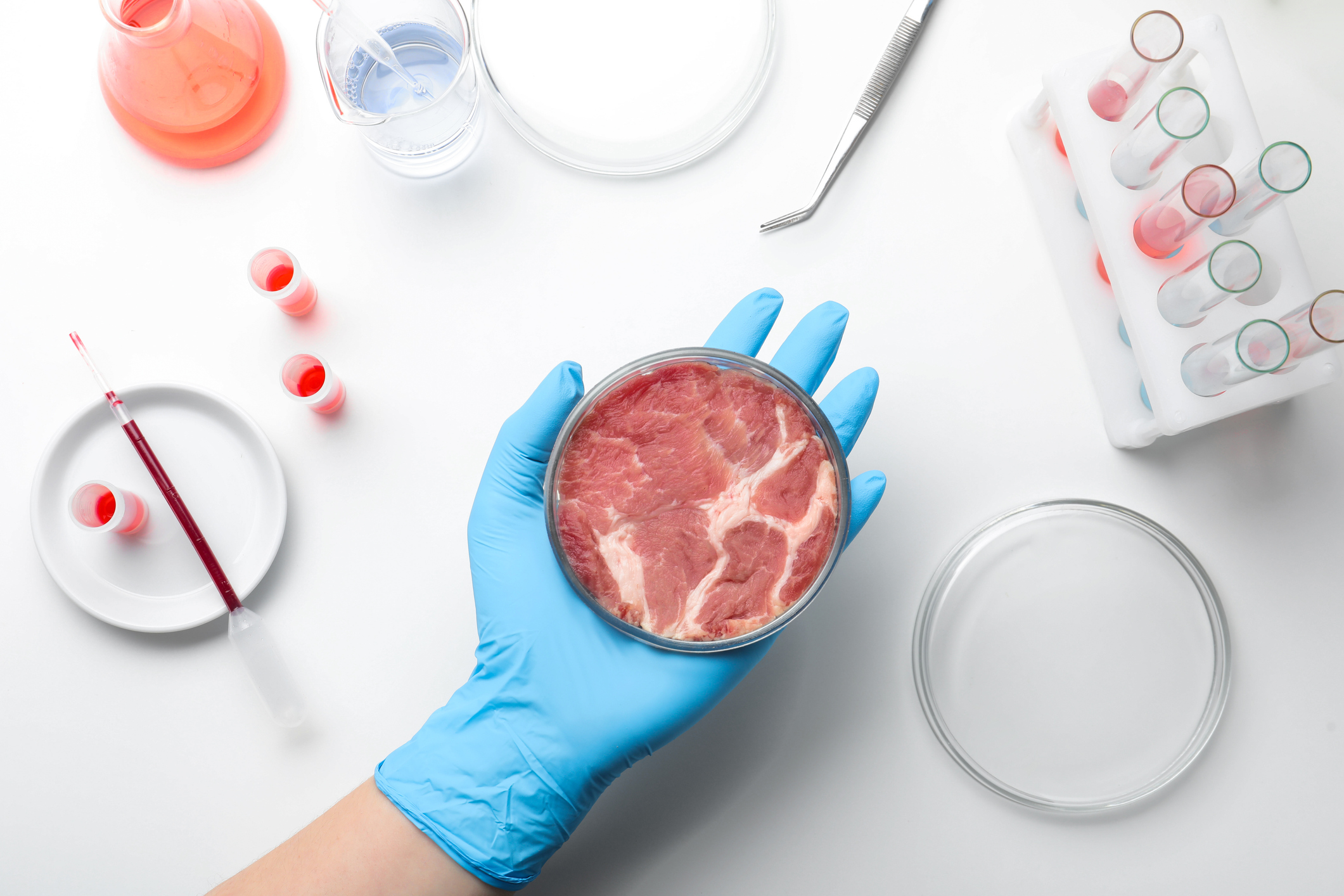Meat has been part of the human diet since before we found fire, but it’s becoming increasingly apparent that the production of meat at scale is more of a detriment to the environment and the world than a benefit.
Across cultures and geographies, animals have been such a vital part of the food chain that it’s hard to imagine a world where animals are not put to the knife to produce protein.
There’s no stopping innovation, however, and alternative sources of protein are increasingly becoming a choice people would rather make.
Cell-cultured meat is one such source. Also known as cultivated or lab-grown meat, this process uses cells from animals to make meat without slaughter. While the nascent sector is a hot topic for the benefits it promises, the process remains slow and costly.
Investments in this sector are heating up, though. If 2021 was anything to go by, there is an abundance of both companies and investors hungry for ways to scale and speed up the process — and do it profitably.
However, it’s not yet clear when meat grown in labs will reach the kind of scale required to see it at your local grocery store.
High steaks
Cell-cultured meat owes its growing popularity, at least in part, to some of the macro challenges the world faces with food production. Overcultivation, human-made climate change and diminishing sources of water are all contributing to a future where food insecurity will be a gigantic problem.
The outlook is bleak: The United Nations estimates food production will need to double to feed the nearly 10 billion people expected to populate the planet by 2050. As for protein, people around the world consumed about 324 million metric tons of meat in 2020, and that number is set to rise even further.
Changing how we cultivate and produce food is key to solving this problem, and we already have systems like vertical farming to address the problem of overcultivation, as well as protein sources other than meat. Currently, alternative protein makes up just about 2% of the animal protein market, but it is expected to increase more than 7x by 2025.
“We are trying to meet the Paris Agreement, but we can’t meet that without addressing the food system and the way we produce meat, eggs and dairy,” said Sharyn Murray, senior investor engagement specialist at Good Food Institute, a nonprofit advocating for reimagined meat production. “The conversion ratio for calories in versus calories out is seven to eight calories for a chicken for one calorie out, while plant-based is one calorie in and one out.”
Cultivated meat is just one of the approaches to meeting future demand for protein alongside plant-based and fermentation techniques. Murray and others I spoke to referred to the movement as “a massive transformation of the food system that will take time.” Meaning the shift will not happen overnight, Murray said.
There is also only one company with cell-cultured meat products available in the market currently: Eat Just, whose subsidiary GOOD Meat has received regulatory approval to produce and sell its cell-cultured meat in Singapore. Eat Just also recently received approval to sell chicken breasts made with cell cultures.

Josh Tetrick, co-founder and CEO of Eat Just, said the movement is here even if people are not buying a lot of lab-grown meat yet.
“It is still small-scale, and the most important thing we are doing that other companies should do is focus on the design, engineering and full-scale installations of vessels and the supporting systems to make a lot of it.”
To reach full scale, about 15 million pounds of meat will need to be produced each year, Tetrick said. At that level, companies will be able to supply a good chunk of the U.S. market and to prominent retailers, restaurants and food distributors.
In addition, meat produced this way is still quite costly — think $50 for a steak right now — and significant consumer education will be necessary to help people understand how companies are making their meat products so that it mimics the taste, texture and aroma of the real thing.
“Getting the cost down will be a critical first step for scaling and profitability,” Murray said.
A world of opportunity, but it’s going to take time
Building the infrastructure and support system to reach scale will take billions of dollars over the course of a decade, Tetrick said. There are not many plug-and-play components; most have to be built from scratch.
Eat Just is investing hundreds of millions of dollars in design, engineering and implementation to be able to produce at a large scale, and he noted that it won’t be producing any significant volume for at least two years.
McKinsey forecasts that the cultivated meat market will be valued at $25 billion by 2030, while Barclays took an even more optimistic outlook by estimating it will be a $450 billion market by 2040. Barclays also predicts that price parity will be reached with traditional meat in five to 10 years.
The Good Food Institute took a look at the cultivated meat market in February 2021 and found that VC investment in the sector rose to $450 million in 2020 from just $60 million in 2019, Murray said.
We’ve also been quite busy reporting on some of those: Animal Alternative, New Age Meats, Orbillion Bio, Eat Just and Tiamat Sciences, to name a few. Aleph Farms and Mosa Meat said last year that actor Leonardo DiCaprio invested an undisclosed amount in both.
This year is poised to match that or even do better — for example, Future Meat Technologies said in December it raised $347 million to make lab-grown meat in the United States.
The fundraise topped a busy year for Future Meat Technologies, which opened its cultivated meat production line in Israel in April. It is now looking at several locations in the U.S. for a large-scale production facility, Yaakov Nahmias, founder and president, told TechCrunch. Pending regulatory approval and facility acquisition, he expects U.S. consumers to be able to try its products in the next year.
The three-year-old company is also proving that it can scale its product and bring the cost of cell-cultured meat down considerably. Future Meat develops its own growth factor and has been able to get the cost down for the cell cultures to $2 per liter versus the industry average of $160 to $170 per liter, Nahmias said.
It uses connected tissue cells called fibroblasts that bring the cost down from $96 per kilogram of chicken in April to $17 per kilogram.
“Other cells, like stem cells, are unstable and don’t grow very well, so most of the volume of your vessel becomes mass and that’s the part that is costly,” he explained. “Fibroblasts are stable and need just a few growth factors and hormones to keep them happy. The price for fibroblasts starts at $50 and drops from there, so our starting point is already five times cheaper than anyone else.”
Who else is cooking?
There has been a flurry of activity in the space in the last few months.
A few companies have cracked the code on a cheaper growth factor, also known as cell feed or media. One of these, Estonia-based Gelatex, grabbed €1.2 million in seed funding to develop a nanofibrous 3D scaffolding material for growing cell-cultured meat.
A bigger player in the space, UPSIDE Foods (which changed its name from Memphis Meats in May), is developing an animal-component-free growth factor that is a major milestone for producing lab meat at scale, founder and CEO Uma Valeti told TechCrunch.
The company in November also opened a 53,000-square-foot engineering, production and innovation center in Emeryville, California. It is designed to produce any species of meat, poultry and seafood, and will initially make more than 50,000 pounds of finished product as it scales to a future capacity of over 400,000 pounds per year, Valeti said.
“We’ve spent the last five years building up our technology and showing the path to price reduction,” he added. “Our facility shows a blueprint for future manufacturing facilities, and our growth media offers hope for the industry that the innovations truly shaping society and making the biggest impact have always been compliant as we move from premium to conventional pricing.”
Israeli cultured meat company MeaTech, which develops biomass cells that are fed into 3D printers to create meat products, announced a partnership with Sound Ventures in October to accelerate its production. The company has 3D-printed a 4-ounce steak made entirely from cultivated cells, a hybrid of plant-based proteins and cell-cultured fat, its co-founder, Omri Schanin, told me, adding that the fat is what enhances the aroma, texture, flavor and mouthfeel.

Currently, MeaTech can produce almost 1 kilogram of cultivated chicken fat biomass in a single production run. For the steak, it takes 10 days from when cells are defrosted. While 3D printing might not seem like a fast way to make food, Schanin said the company is producing a multi-nozzle system that will eventually print a very large quantity of steaks in less than a minute.
MeaTech plans to open a pilot plant in Belgium in 2022 and begin production of its cell-cultured fat at scale. It intends to sell that to plant-based producers who are looking to enhance the flavor and meatiness of their products, like chicken nuggets and vegetarian sausages.
“All of this recent news validates the technology that many companies are working on,” Schanin said. “There are differences between the companies, but the general idea repeats itself in that we are all trying to prove we can enable mass production of our products in the future.”
Who’s backing cell-cultured meat, and one who isn’t
Due to the amount of investment activity in this space, it is safe to say that some traditional venture capital firms and protein producers have found something they like about cell-cultured meat.
On the producer side, both Cargill and Tyson Ventures invested in UPSIDE Foods four years ago and were joined by SoftBank, Norwest, Temasek, Threshold Ventures and Finistere, to name a few. Tyson was also an investor in Future Meat Technologies, as is ADM Ventures.
New Age Meats’ investment came from South Korea-based Hanwha Solutions and existing investors SOSV’s IndieBio, TechU Ventures, ff VC and Siddhi Capital.
In addition to VCs, Eat Just is backed by several governments, including the Qatar Investment Authority and Singapore Food Agency.
However, Joško Bobanović, partner at Sofinnova Partners, told TechCrunch his venture group, one of the oldest in Europe, has not yet invested in the sector. His firm has seen technologies it is interested in, but has not yet found “the princess among the frogs,” he said.
Some of the measures Bobanović considers for cell-cultured meat is where a company is on the cost curve and what key milestones it has overcome to bring products to a cost that will be acceptable to the system. He is also not confident about consumers’ reactions and whether they will buy the products, saying the cost drop itself will not be enough — it will take lots of people trying the products.
“This is where we come into discrepancies in thinking,” he said. “We have been around startups that went to cost curve, but their dependency is on the growth factor, or the growth media, but there is less price sensitivity here, and is one of the parts of the ecosystem that needs to mature to bring the cost to an affordable level.”
Other prominent investors in the space include At One Ventures, True Ventures and Blue Horizon.
Friederike Grosse-Holz, a director at Blue Horizon with a background in bioinformatics and protein biochemistry, told TechCrunch the technology is indeed still in its early days, especially for companies trying to create whole cuts of meat.
She said cultured meat is “a little like a moonshot” now, but felt that will change once price parity comes in the next decade or so and hybrid products come to market, which are the early forms of meat made with proteins plus the cultured cells.
Grosse-Holz was one of the authors of a BCG/Blue Horizon report on the sector and said their research forecasts that 11% of all the meat, seafood, eggs and dairy eaten globally by 2035 will be from an alternative source. That is the same time frame given for when those products will reach full parity in taste, texture and price with conventional animal proteins.
“We are far from clear in knowing which technology will be the best,” she said. “The difference will be in how it works, what media you feed the cells, how you grow them — if they will bond to something or be in suspension — and that will then determine what equipment is needed. So it is good there are so many players and a space for them.”
The future of meat?
Eat Just’s Tetrick believes regulation is one of the biggest hurdles to scaling production.
“This is not approved in 198 countries, but only in one country, so we are not even close to effecting the change we want,” he added.
Many of these companies are actively working with the U.S. Department of Agriculture and U.S. Food and Drug Administration to get regulatory approval to offer their cell-cultured meat on this side of the world.
In September, the USDA sought public comment on the labeling of meat and poultry products made in this manner, which many of the founders see as a positive step.
It’s is “a promising sign,” GFI’s Murray said, and when the U.S. has regulations in place, other countries will follow.
Once UPSIDE Foods gets the regulatory green light, Valeti said it will begin producing at limited capacity and initially launch through restaurants as it ramps up its larger commercial facility. He expects the facility to take a few years to be constructed and begin operations, but he is optimistic that it could take just two to five years before UPSIDE’s products will make it to grocery store shelves.
Meanwhile, the 2030 time frame predicted for cell-cultured meat to reach the mainstream isn’t out of reach, Blue Horizon’s Grosse-Holz said. She feels there are a couple of technology “step changes” that still need to happen, especially at companies aiming for whole cuts of meat.
Overall, the next steps will be about cost, consumer acceptance and adoption, she said.
“This is not a revolution, it is a transformation, and it is going to take time,” Grosse-Holz added. “Food is tied to emotion, and if it feels like you have to change your food, it will be hard. But if you can change your mind around the way we make food, what a climate-friendly diet will look like and the ethics around animal farming, this may be a way where you don’t have to give up the indulgence around the barbecue, but can do something better for the planet, animals and humankind.”































Comment